U.S. Department of the Interior Bureau of Land Management
Eagle Lake Field Office
2550 Riverside Drive
Susanville, CA 96130
RE: Environmental Assessment DOI-BLM-CA-N050-2019-0011-EA
Bureau of Land Management (BLM) Twin Peaks Herd Management Area Wild Horse and Burro Gather Plan 2019
ATTN: Brian Novosak, Jeff Fontana, and Amanda Gearhart (Via Email BLM_CA_twinpeaksgather@blm.gov , BLM_CA_Web_EL@blm.gov, agearhart@blm.gov, jfontana@blm.gov
Background
I hold a Masters in Environmental Planning with a background in Biology and have spent significant time completing my graduate work, and masters thesis researching, surveying and documenting the conflicts related to livestock grazing, wildlife, and wild horses and burros within the Twin Peaks Herd Management Area. The following are my preliminary comments on the Environmental Assessment (EA).
My recent visit to the Twin Peaks HMA on May 10th, 11th and 12th included both an aerial population survey and ground field assessment. My findings are there is no “overpopulation” of wild horses and burros.
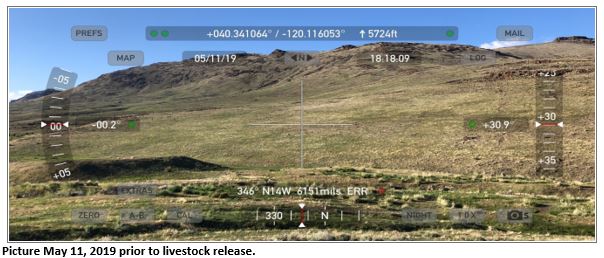
The ecosystem and wild horse and burro populations appear to be achieving a “thriving natural ecological balance” consistent with the BLM mandates. The removal of wild horses and burros is the offices status quo in favor of livestock and fails to consider alternative management plans that protect public lands. The EA and BLM fails to prove that removing wild horses and burros improves conditions; while still authorizing intense livestock grazing.
Ecological Contributions of Wild Horses and Burros
The EA does not provide any discussion of the science and ecological contributions of wild horses and burros to the biological diversity on public lands or the negative impacts to wild horses and burros under this plan.

In addition to the following scientific body of knowledge, my research has found that wild horses and burros contribute to the ecosystem and diversity in the Twin Peaks HMA. They are unique in possessing less efficient post-gastric digestive systems that contribute to higher material passage rates (Feldhamer, Thompson, Chapman, 2003). Horses also tend to utilize more abundant, but poorer nutritional quality plant species (Feldhamer, Thompson, Chapman, 2003). Horse droppings pass most seeds intact, which facilitates seed dispersal, and cycles nutrient rich material that builds soil moisture retention resulting in an increase in native plant diversity near horse trails (Downer, 2007) (Ostermann-Kelm, Atwill, Rubin, Hendrickson, Boyce, 2009).
Furthermore, competition between wild horses and burros and other native or domestic species has not been substantiated (Feldhamer, Thompson, Chapman, 2003). Wild horses utilize a broader range of plant species in their diet and are one of the least-selective grazers in the western states (Beever, 2003). Approximately 80% of their diet is composed of shrub and grasslands with less than 1% comprised of riparian vegetation (Berger, 1986). Burros tend to have a broader diet, which includes approximately 50% of browse species such as trees, shrubs and vines with the rest was comprised of grasslands (Feldhamer, Thompson, Chapman, 2003).
Wild horses and burros use the land and resources at different intensities throughout the year, allowing for a natural rest and rotation of foraging pressures (Downer, 2007). Also, wild horses and burros tend to use relatively few trails in traveling to and from grazing, resting and water sources which minimizes trampling and riparian damage near waterways (Beever, 2003) (Ganskopp, Vavra, 1986). These adaptations minimize impacts to their environment and illustrate sustainable integration within the ecosystem.
Native Species
The science is conclusive that horses originated in North America. However, the BLM does not recognize them as a native species. Opponents argue that since the wild horses were absent from the Americas and then were re-introduced after a period of domestication, they are not a native species. This concept is inconsistent with modern molecular biology and theory. Mitochondrial DNA analysis has proven that Equus caballus is genetically equivalent to the horses found in the North American fossil record (Forsten. 1992). Wild horses meet criteria as a native species by both origin and co-evolution with the habitat in North America, so a period of domestication is “biologically irrelevant” (Kirkpatrick, Fazio, 2008).
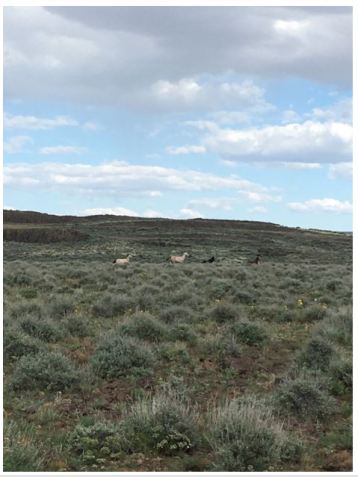
Wild horses and burros are classified by the BLM as a national heritage species. This classification places them in a specialized category as neither wild nor domestic, which subjects them to management considerations that are inconsistent with conventional wildlife practices and legal protections, such as the Endangered Species Act (Kirkpatrick, Fazio, 2008).
The EA is inadequate and full assessment of the wild horse and burro populations by not considering an adjustment to the Appropriate Management Level (AML) or livestock use. The EA relies on outdated planning documents from 2001 when this office revised the AML for the Twin Peaks Herd Management Area in the Final Multiple Use Decisions for the Twin Peaks Allotment and then was re-affirmed in the 2008/2009 Resource Management Plan. This EA clearly does not represent new findings about both wild horses and burros and the current conditions and impacts of fire, and heavy livestock use within the Twin Peaks HMA.
This office should be reminded that AML is only an administrative tool to establish population levels to minimize range degradation and is subject to re-evaluation by the Field Office as needed (BLM RMP, pg. 136, 2008). In addition, this office acknowledged that a new herd management plan is needed (scoped in July 2016 and not completed) and the current herd management plan is over 30 years old (1989) and a new one should be completed prior to any EA that relies on its findings to remove wild horses and burros.
The EA appears to pre-determine a solution of removing wild horses and burros without full and adequate analysis of the livestock grazing impacts or serious consideration of cancelation or reduction in livestock AUMs or permits.
Population, Surveys and Methodology
Several scientifically accepted aerial methods exist to estimate wildlife populations within a large area. Here we employed the “aerial, straight-line-strip-transect” method for estimating relative population density. In this, the transect strip relative to the total area allows a density ratio to be determined. As modified by other variable factors, this ratio is then used to estimate a low-to-high population range. Our survey was adapted from the Guenzel methodology for estimating the population size of pronghorn and other wildlife species (Guenzel, 1997). Conducting a complete flight survey in a single day or flight provides data that are more accurate. The sampling includes a variety of habitats with adequate transect spacing and minimizes concerns about animal movements that can lead to multiple counts of the same individuals and over estimation of the population. As stated below by this office.
“Based on recent census flights and population growth estimates, the BLM believes there at about 3,500 wild horses and 600 wild burros in the HMA.”

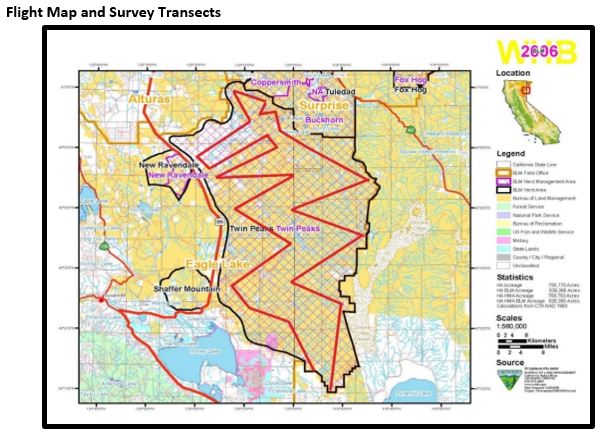
Flight Surveys Details with Census Data
I completed the most recent flight on May 11, 2019. The aerial survey flight left the Susanville Airport at 9:06 AM and returned at 11:21 AM with no stops. The weather presented mostly clear skies with light wind with approximately 30 miles of visibility. A temperature reading of 57° Fahrenheit was taken at flight departure. Aerial transects were randomly selected and flown to cover both previously burned and un-burned portions of the Twin Peaks Herd Management Area. A total of 218 transect miles were surveyed; and totals of 255 wild horses and 16 wild burros were counted during the survey. The survey covered the same path and transects as the flights completed in 2016 and 2017.
Our observed area included all five BLM-assigned wild horse and wild burro “home ranges” within the HMA. Flight height above ground level varied from 800 to 1,000 feet; and there was an adjusted transect strip on both sides of .37 and 0.41 of a mile on each side of the plane. The transects flew through all nine of the major livestock grazing allotments within this wild horse and burro herd management area. The Twin Peaks wild horse and burro herd management area is separated into livestock grazing allotments by fencing and/or natural barriers in order to control domestic livestock movements. However, these fences also restrict wild horse and wild burro movements as well as other wildlife; and this is contrary to the “free roaming” lifestyle mandate for wild horses and burros under the Wild Free Roaming Horses and Burros Act (WFRHBA,1971).
Twin Peaks Independent Population Surveys
This flight is the seventh independent aerial population survey for the Twin Peaks Wild Horse and Burro Herd Management Area since the massive removal of wild horses and burros during the summer of 2010. These surveys have also documented significant fire damage to soils and vegetation and the slow recovery of such within burned areas. We have also documented the continuing livestock trespass on the public lands in the Twin Peaks HMA. The previous aerial survey reports, including photos and videos, have been formally published and are available for reference.

The independent surveys indicate that the Twin Peaks wild horse population has been increasing for the past nine years. Independent research has demonstrated that the annual herd increase, factored from foal survival rates, is approximately 10% for wild horses in the Great Basin region (Gregg, LeBlanc, Johnston 2014). The higher population increase observed is likely the result of a compensatory reproductive responses to the massive wild horse and wild burro removals in 2010.
Compensatory reproduction occurs when an animal’s population is greatly reduced, and this can be either as a direct or indirect consequence of management actions, including bait and water trapping and helicopter-aided removals. Compensatory reproduction involves an increase in fertility and foal and adult survival, and is largely attributed to reduced competition for food, shelter, and other species-specific habitat requirements (NAS, 2013).

The survey and population estimates for wild burros indicates irregular population growth. This is attributed to the relatively small burro population size and also substantiates the documented burro removals that have recently occurred.
Since 2010, the BLM Eagle Lake Office has trapped and removed at least 22 burros from the Twin Peaks Herd Management Area. These removals occurred between October 2012 and November of 2013. Furthermore, in 2014, the BLM officials filed a decision record stating that they would be capturing and removing from 90-110 wild burros from the Twin Peaks Herd Management Area (NEPA Register, 2015). It is currently not known whether this action has been completed, but the smaller burro population detected during the 2014 survey indicates that it has. In addition, in January of 2017 the BLM Eagle Lake field office signed a categorical exclusion document stating that they will be capturing and removing an additional 150 wild burros from the Twin Peaks HMA area within the following 12 months (NEPA File # DOI-BLM-CA-2017-06-CX).
Impacts of Livestock Grazing
The BLM permits livestock grazing on 94% of the public lands it manages in the western states (Fleischner, 1994). It is estimated that livestock grazing has negatively impacted at least 80% of riperian ecosystems in the western states (U.S. Department of the Interior, 1994a, as cited in Belsky, Matzke, Uselman, 1999). Below is an example of the damage caused by grazing of livestock within the Twin Peaks HMA.
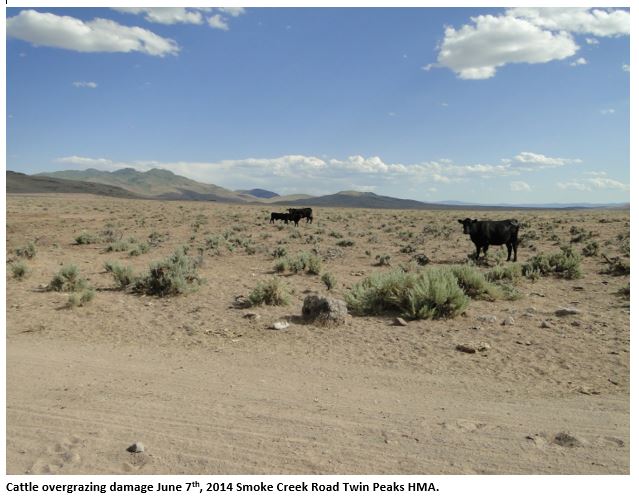
Studies have found that livestock tend to congregate in riparian areas, which negatively impacts the biodiversity and biophysical functioning of these ecosystems (Fleischner, 1994) (Marlow, Pogacnik, 1986).
Livestock grazing has at least the following major impacts:
- Significantly Alters Plant and Animal Communities (Wagner 1978, Jones 1981, Mosconi & Hutto 1982, Szaro et al. 1985, Quinn & Wal-Genbach 1990, as cited in Fleischner, 1994) (Belsky, Matzke, Uselman, 1999) (Donahue, 1999) (Wuerthner, Matteson, 2002)
- Decreases Biodiversity (Fleischner, 1994) (Wilcove, Rothstein, Dubow, Phillips, Losos, 1998) (Belsky, Matzke, Uselman, 1999) (Wuerthner, Matteson, 2002)
- Elimination of Native Predators (Donahue, 1999) (Wuerthner, Matteson, 2002) (GAO, 2005)
- Elimination of Native Predators (Donahue, 1999) (Wuerthner, Matteson, 2002) (GAO, 2005)
- Introduction of Invasive Plants and Diseases (Mackie 1978, Longhurst et al. 1983, Menke, Bradford 1992, as cited in Fleischner, 1994) (Wilcove, Rothstein, Dubow, Phillips, Losos, 1998) (Donahue, 1999)
- Soil Compaction and Accelerated Erosion (Fleischner, 1994) (Belsky, Matzke, Uselman, 1999) (Donahue, 1999) (Wuerthner, Matteson, 2002)
Livestock Allotment Boundaries Limit Free Roaming Behavior and Genetic Mixing
The Twin Peaks wild horse and burro home ranges correlate with livestock allotment boundaries. Livestock allotments are based on fence-lines and natural boundaries restrict wild horse movement to benefit livestock grazing. See maps below showing the livestock allotment and wild horse and burro home range correlations and existing fencing boundaries.
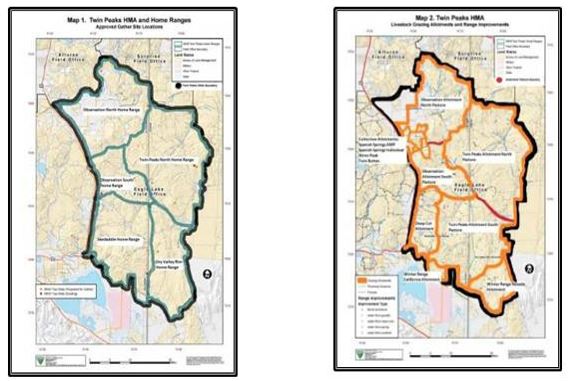
Genetics
Significant controversy by wild horse and burro preservation groups centers around the genetic viability of wild horse and burro populations. Small isolated or sub-divided populations are subject to reduced genetic diversity (Goodloe, Warren, Cothran, Bratton, Trembicki, 1991). Reduced genetic diversity can “impair vigor, fertility, and disease resistance and could limit ability to respond to environmental variation” (Beard-more 1983, as cited in Goodloe et al. 1991). Other research has shown that significantly reducing populations can result in genetic bottlenecks and within the populations there are hidden population structures that result in behavioral isolation, which further restricts gene flow (Ashley, 2004).
According to the Federal Land Policy Management Act, “wild horses and burros shall be managed as self-sustaining populations of healthy animals in balance with other uses and the productive capacity of their habitat” (FLPMA, 1976). However, according to the leading wild horse genetic expert “the majority of wild equid populations managed by the BLM are kept at population sizes that are small enough for the loss of genetic variation to be a real concern” (Cothran, 2000).
The appropriate population size is dependent on the number of breeding adults and other management considerations specific to the population (Goodloe, Warren, Cothran, Bratton,Trembicki, 1991). The International Union for Conservation of Nature or IUCN Species Survival Commission recommends a minimum of 2,500 individuals are needed to maintain a viable wild population (IUCN, 1992). Other research indicates that an “absolute minimum” of 139-185 wild horses are needed to maintain a population that undergoes several removal disturbances during a generation (Singer, Aeignefuss, 2000). This number represents an “absolute minimum” and is not an ideal population size.
The Twin Peaks Herd Management Area is managed as “5” separate home ranges that divide the wild horses and burros into sub-populations. Only “2” of the “5” home ranges meet the “absolute minimum” population level for wild horses as defined by Singer and Aeignefuss (2000). None of the home ranges meet the minimum population level for wild burros. See table below.
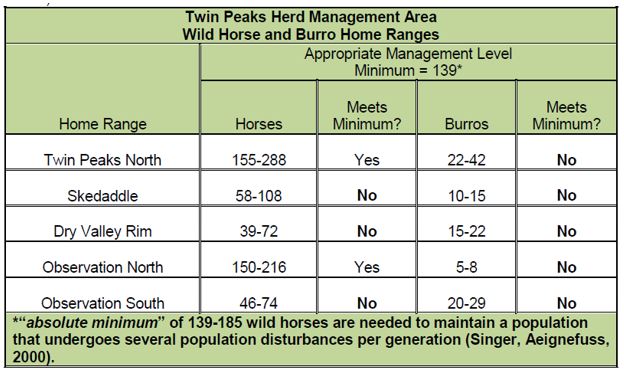
The Twin Peaks Herd Management Area removal plan included a provision to include genetic testing for the horses and burros removed from the Twin Peaks Herd Management Area (BLM NOD, 2010). The genetic testing and results were completed for the wild horses in April 2011, but testing was not done as of October 2011 for burros. The BLM Eagle Lake Field Office did not provide a response to inquiries as to why the burros were not already tested. According to the California BLM State Directors Office the genetic test results are expected between April and July 2012, almost two years after the burros were removed.
Genetic testing was completed on 94 wild horses removed from the Twin Peaks Herd Management Area (Cothran, 2011).
The genetic testing results acknowledged the known population subdivision within the Twin Peaks Herd Management Area, and concluded that the heterzygosity or genetic variation is “approaching concern levels” (Cothran, 2011). This report reflects the population in 2010 prior to the removal of 1,637 wild horses, which significantly reduced the population and compounds concerns regarding genetic variation for the remaining wild horses.
Previous genetic testing for burros was completed in 2003 on “4” burro populations in California showed low heterzygosity or genetic variation in all of the burro populations (Cothran, 2003). No action was confirmed by the BLM to improve the genetic viability for burros. Burros in Twin Peaks remain at significant genetic risk.
Conclusion
I expect that the office will consider the comments provided and provide a full environmental assessment that provide clear evidence that wild horses and burros are compromising the “thriving natural ecological balance” and not livestock grazing, hunting, OHV use, water diversions, predator removal, fire, juniper removal, climate change, and inadequate management policies as I have witnessed and documented over the past nine years of my research.
The office should be prepared to show that any action to remove or disturb the wild horses and burro population (ie. fertility controls) will not cause irreparable harm to the populations and that the plan is not based on outdated planning documents in favor of livestock interests.
I appreciate the consideration of my comments provided in regards to the EA for the Twin Peaks Herd Management Area. I am open to a discussion leading to a sustainable environmental plan that balances and protects all of the natural resources in this region.
Please contact me should you have any questions about my comments or research provided.
Jesica Johnston
References
Beever, E. (2003). Management implications of the ecology of free-roaming horses in semi-arid ecosystems of the western United States. Wildlife Society Bulletin, 31, 887-895.
Berger, J. (1986). Wild Horses of the Great Basin: Social Competition and Population Size. Chicago, IL: University of Chicago Press.
Conservation Strategy for Sage-Grouse (Centrocercus urophasianus) and Sagebrush Ecosystems within the Buffalo-Skedaddle Population Management Unit (Northern California Sage-Grouse Working Group, 2006). http://www.blm.gov/pgdata/etc/medialib/blm/ca/pdf/eaglelake.Par.29222.File.dat/FINAL %20B- S%20PMU%20S-G%20CONSERVATION%20STRATEGY.pdf
Downer, C. (2007). Wild Horses: Living Symbols of Freedom. Minden, NV.
Feldhamer, G., Thompson, B., Chapman, J. (2003). Wild Mammals of North America: Biology, Management, and Conservation. Baltimore, MD. The John Hopkins University Press.
Forsten, Ann. (1992). Mitochondrial-DNA timetable and the evolution of Equus: Comparison of molecular and paleontological evidence. Ann. Zool. 28, 301-309. Retrieved from http://www.sekj.org/PDF/anzf28/anz28-301-309.pdf
Ganskopp, D., Vavra M. (1986) Habitat Use by Feral Horses in the Northern Sagebrush Steppe
Journal of Range Management, 39, 207-212. Retrieved from http://www.jstor.org/stable/3899050
Johnston, J. (2011). California’s, Wild Horses and Burros: Twin Peaks HMA. http://csusdspace.calstate.edu/xmlui/bitstream/handle/10211.9/1492/WHB_Thesis_Final%2011. 30.11.pdf?sequence=1
Kirkpatrick, J., Fazio, P. (2008). ECCE EQUUS. Natural History, 117, 30-31. Retrieved from http://ebscohost.com.proxy.lib.csus.edu
Kirkpatrick, J., Fazio, P. (2010). Wild Horses as Native North American Wildlife. Retrieved September 4, 2011 from: http://wildhorsesinwindsofchange.com/wp-content/uploads/2011/02/Wild- Horses-as-Native-North-American-Wildlife-Updated-January-2010-FINAL.pdf
Ostermann-Kelm, S., Atwill, E., Rubin, E., Hendrickson, L., Boyce, W. (2009). Impacts of feral horses on a desert environment. BMC Ecology, 9. Retrieved from http://www.biomedcentral.com1472- 6785/9/22
Wild Horse and Burro Handbook (BLM, 2010). http://www.blm.gov/pgdata/etc/medialib/blm/wo/Information_Resources_Management/policy/ blm_handbook.Par.11148.File.dat/H-4700-1.pdf
Categories: Wild Burros, Wild Horses/Mustangs









The BLM; Federal Government, etc., are inviting a lawsuit to cease the removal of the Wild Horses; burros.
LikeLiked by 2 people
And this is what a correct, professional survey is supposed to be! Apparently, when the BLM does it – they have to stop the counting of horses because the “””surveyor””” is nauseous!
Thank you Jessica
LikeLiked by 2 people
The BLM doesn’t take many photos and I’m not aware of any video taken on a regular basis. In Wild Horse Freedom Federation’s recommendations sent to members of Congress, we asked for BLM’s aerial population surveys to include video.
LikeLiked by 2 people
I remember reading some time ago that the BLM did some kind of aerial “count” – and their reason for not completing it was the person doing the count was nauseous or dizzy? That seems to me to be the epitome of idiotic excuses – agree?
LikeLiked by 2 people
You are correct.
“In the flyover subsidized by the Rock Springs Grazing Association in April 2015, which conveniently did not include photographs because “The survey lead indicated his reluctance to use photography, as it requires additional circling around groups that could cause air sickness”.
https://rtfitchauthor.com/2016/05/02/action-alert-adobe-town-wild-horses-in-wyoming-under-siege-again-please-comment-by-may-6/
LikeLiked by 1 person
I absolutely agree, Maggie.
LikeLiked by 2 people
Question: Why, oh why does the BLM not use Go-Pro on their aerial surveys?
Answer: Because it would prove without a doubt that their survey results are fraudulent.
LikeLiked by 1 person
Excellent critique of Blm’ disastrous plan for the Twin Peaks Wild Horses and Burros! Pray they will listen 👂 and reform to tear down those illegal fences and reduce those sheep and cattle and allow the wild equids to fill their respective niches and play their respective ecosystem restoring roles, which includes catastrophic wildfires mitigation and even prevention! Blm’s dam Plan is a giveaway to the ranchers and a death sentence for America’s cherished wild mustangs and sagacious wild burros both of whom have their deep evolutionary roots right here in North America including Twin Peaks!!!!
LikeLiked by 2 people
Awesome comments with facts.
LikeLiked by 2 people
Being from Australia we do not have this level of research to adequately support arguments against removal of our Brumbies . Reading this is certainly uplifting to know how research that is balanced, referenced, transparent and factual can only help . You are to be applauded.
LikeLiked by 2 people
Our United States of America society relies heavily on the ability to produce and exchange legitimate and trustworthy documents. In the current 2019 Twin Peaks EA the BLM refused to include or even acknowledge factual scientifically defensible relevant data which by law must be provided to the public in the environmental assessment. Instead of scientifically supported information, the BLM agency included multitudes of false information.
Examples:
The BLM published a population chart (now removed from the public – but I have it) which stated that the 2010 pre-gather horse population was 2236 and that 1637 were gathered leaving a post-population of 793 horses. Note: common mathematics shows us that 2236 minus 1637 equals 599 and not 793.
Similarly, on the chart BLM stated that the 2010 pre-gather burro population was 231 and that 162 were gathered leaving a post-population of 160 burros. Note: common mathematics shows us that 231 minus 162 equals 69 and not 162.
These false population numbers are then compounded and used to perpetuate highly inflated populations for years to come.
These two above mentioned examples are what is known in the accounting world as “cooking the books”. Cooking the books is a slang term for using accounting tricks to make results look more attractive than they really are. Typically, cooking the books involves manipulating data to inflate and/or misrepresent the actual accurate condition of the specific entity in review by providing false or misleading information. It is illegal and punishable.
Jesica Johnston has spent years studying the Twin Peaks HMA, including numerous aerial and ground surveys as well as using Twin Peaks as the subject of her Masters Thesis. http://csus-dspace.calstate.edu/handle/10211.9/1492
LikeLiked by 1 person
Actual aerial survey Go-Pro footage of one Twin Peaks flight done by independent volunteer scientists.
https://rtfitchauthor.com/2013/12/07/counting-wild-horses-an-aerial-tour-of-twin-peaks-wild-horse-and-burro-habitat/
LikeLiked by 1 person
Just so you know how the BLM does their so-called “scientific studies”…
A few years ago, BLM Director’s Challenge awarded $300,000 to assist field offices in on-the-ground volunteer field research about our wild horses and burros and our public lands. The research on the public lands was to be done by the public under the direction of BLM. I witnessed a member of the public who just happened to be an environmental scientist/ biologist (obviously the BLM representative didn’t know that) getting a return phone call from BLM Eagle Lake field office employee Derek Wilson, the coordinator for this “volunteer opportunity”.
This BLM representative told the potential volunteer that the assessment was to be on the Twin Peaks HMA and all usage found was to be counted as wild horse and burro usage regardless if the usage was from private livestock or other wildlife. Since this was to be done on an HMA that had 82% of its forage allocated to privately-owned domestic livestock the biologist asked how the study would differentiate between the usage of livestock and wild horses/burros. The BLM told the biologist that ALL usage observed during the study would be attributed to the wild horses and burros … ALL … and none to the livestock or any other possible user – regardless of the fact private domestic livestock was permitted about 5 times more than the permitted wild horses and burro usage. It clearly appeared from what the BLM representative explained, that the BLM were going to use the public volunteers to gather information to paint another negative picture for the horses and burros based on this fraudulent, non-scientific study.
I was in the room during the phone call. The biologist remained cool calm and collected and polite … but got the same “all-resource-usage-observed would be delegated to the wild horses and burros’ usage” explanation from the BLM over and over. It was obvious to me that the BLM representative had no idea he was talking to a biologist and experienced wild horse and burro observer who was completely knowledgeable of the entire issue. The BLM representative had trapped himself in an attempted fraudulent so-called study but his canned response was not fooling this scientist. With a scientist’s point of view, the biologist politely continued to ask the same question until the BLM representative became rude with the potential volunteer and threatened to hang up and discontinue the phone call. Although this supposed scientific study was ultimately unsuccessful and just so we all are aware … that is how the BLM does their so-called “scientific studies”.
Per information I acquired from BLM’s Nancy Haug, the Eagle Lake BLM field office never did approve a single volunteer for this project although she admitted they did keep $9,000 of the $25,000 that was designated to go to this aborted research project.
http://www.blm.gov/wo/st/en/info/newsroom/2012/march/nr_03_22_2012.html
LikeLiked by 1 person
Jesica Johnston’s academic credentials, together with her many years of observations and research, made her eminently qualified to comment on the Twin Peaks EA. Her knowledge of range-and-riparian conditions on Twin Peaks is surely more comprehensive than that of all the staff at the Eagle Lake Field Office combined. Her report is powerful. Great job!
LikeLiked by 1 person
And if this government agency was as professional and QUALIFIED as Jesica Johnston – then we all could be sure that they would accept this comment in order to do the right thing for these wild animals. Or the comments by Grandma Gregg, Mary Beth Devlin, Craig Downer, & so many others whose knowledge & experience & compassion for wild horses & burros is something that it appears no one in the BLM can comprehend or understand. It just seems that all of these comments from thousands of caring people just go into the black hole that is the BLM!
LikeLiked by 2 people
Thank you for the insightful comment and I hope you know that each and every person that you mentioned (and many more!) were independent volunteers and none received compensation for their research contributions.
Now, why do we think that these qualified individuals would spend years of research (and their own time and own money) to study these wild horses and burros and their habitat on our public lands? Because they have seen, heard and personally experienced the fraud and animal abuse that the BLM agency has forced down the throats of the public and congress and are abhorred by this fraud and treachery.
LikeLiked by 1 person
I’m a tad late becoming aware of this “issue” – maybe past 15-20 years. And I’m well aware that reading about whats been done to the wild horses & burros for 40-50 (probably more) years sure isnt the same as having experienced it first hand – I really give you all so very much credit for hanging in there and just keeping on. I hope that we all dont have to wait another 1/2 century or so (!) before there is some kind of correction to the way these animals have been treated. A BIG correction!! Maybe – just maybe – the 2020 election could bring some change but as much as I hate to admit this (having changed from an R to a D) its not just one party – its the system that allows this kind of corruption that needs to change. And I know all of us do realize that!
Have to say – this venue and the people give me hope.
LikeLiked by 2 people
It’s so nice to read an actual, scientifically based paper on this issue 🙌🏼 I’ve been following these horses since I was 6 years old, and have always questioned the BLM in their reasoning and methods for removing these horses.
LikeLiked by 2 people
THANK YOU Jesica for sharing your powerful and factual letter and for showing us what REAL Range Science looks like.
You truly understand what it takes to achieve a Thriving Ecological Balance..and why there hasn’t been one for a very long time.
LikeLiked by 2 people
CALIFORNIA’S WILD HORSES AND BURROS
Jesica Johnston
B.A., California State University, Sacramento, 2007
THESIS
http://csus-dspace.calstate.edu/bitstream/handle/10211.9/1492/WHB_Thesis_Final%2011.30.11.pdf?sequence=1
Pages 41, 42 and 43
Fencing
There is extensive fencing within the Twin Peaks Herd Management Area. The 1976 Federal Land Management Policy Act requires that “management activities affecting wild horses and burros shall be undertaken with the goal of maintaining free- 42 roaming behavior.” In 1989, the BLM Eagle Lake Field Office adopted the Twin Peaks Herd Management Area Plan which subdivided Twin Peaks into five sub-herds or home ranges based on livestock allotments and pasture fencing (BLM HMAP pg. 7, 1989). Fencing restricts wild horse and burro movement, natural migration, and access to water and forage resources within the Twin Peaks Herd Management Area. See figures 14 and 15 below for an example of the fencing and cattle guard barriers.
PHOTOS
Page 40 Twin Peaks Herd Management Area Big Spring partially fenced riparian area near Observation Peak.
Figure 14 Twin Peaks Herd Management Area fencing near Rye Patch Road
Figure 15 Twin Peaks Herd Management Area cattle guard on Rye Patch Road.
LikeLiked by 2 people
Send a Fax to your Senators
https://faxzero.com/fax_senate.php
LikeLiked by 2 people
Make a phone call, send and email or fax or write a letter
KAMALA D. HARRIS
U.S. Senator for California
https://www.harris.senate.gov/contact/offices
LikeLiked by 2 people
I have found that calling the local offices is more productive than calling the D.C. office and you often find staff members who are very interested and grateful that you called and gave them information. Some don’t even realize that we have Herd Management Areas in California.
Senator Dianne Feinstein
https://www.feinstein.senate.gov/public/index.cfm/contact
LikeLiked by 2 people
Lassen County Times and Westwood Pine Press
https://www.lassennews.com/
LikeLiked by 2 people
THE SACRAMENTO BEE
Submit your letter to the editor
https://www.sacbee.com/opinion/letters-to-the-editor/submit-letter/article2807060.html
LikeLiked by 2 people
SAN FRANCISCO CHRONICLE
Use this form for Letters to the Editor for publication:
https://www.sfchronicle.com/opinion/letters-editor/item/How-to-submit-Letters-56188.php
LikeLiked by 2 people
SAN FRANCISCO EXAMINER
Contact Us
https://www.sfexaminer.com/contact-us/
LikeLiked by 1 person
So here’s some food for thought…….
What kind of effect will adding geldings have to the already controversial issue of genetically viable herds? If geldings will now be included in the maximum populations allowed, won’t this create the illusion that wild herds are more genetically viable than they really are?
For example, if a herd has an AML of 100 but BLM gelds 20 of the stallions and return them to the range, in actuality only 80 wild horses are now capable of breeding. When someone looks at the AML, unless they know that geldings have been included in that herd, they will think the herds are more genetically viable than they really are.
But then again, that’s the best-case scenario. When BLM rounds up wild horses and burros, they usually leave only 40% of what “high” AML is. So after BLM rounds up those same 100 wild horses, they would usually remove about 60 of them and leave 40. What happens if 20 of those are now geldings? Isn’t the breeding population now only 20? And what about horses too old or too young to breed in the 20 now left?
And once BLM begins gelding them, will they have to tell the public every time they geld more or only the first time? Will they start with a proposal that gelds 20 stallions but will more be gelded every time they do a round up? Will they be required to tell us “We plan on gelding 5 more? 10 more? 20 more? Or will they just do it based on their own best judgment?
http://americanherds.blogspot.com/2008/02/
LikeLiked by 1 person
AND what does it do to these little bands & the whole herd when the stallions are gelded? Apparently there is no curiosity at all from the BLM as to any change in herd behavior etc. Seems the only curiosity they have is when they spay wild mares. Even then we all know they dont give a hoot one way or the other – whatever shrinks the numbers! This particular blog was eleven years ago but the mindset is the same. Or the lack of mind.
LikeLiked by 2 people